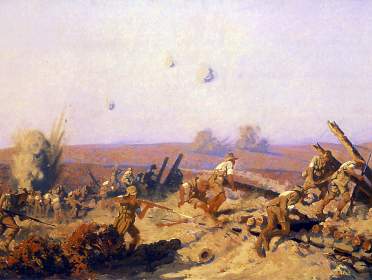Gallipoli Campaign

The Gallipoli Campaign, also known as the Dardanelles Campaign and the Battle of Gallipoli went into history as one the greatest Allied disasters in World War I. The campaign with the objective to capture the Ottoman capital of Constantinople (today’s Istanbul) was proposed by Winston Churchill who was at the time First Lord of the Admiralty. Churchill’s plan which foresaw exclusively a naval operation was promising because if successful, it would open a sea route to Russia in the Mediterranean that was closed after the Ottoman entry in the war on the side of the Central Powers in October 1914. In addition, the capture of Constantinople would relieve the pressure on both Western and Eastern fronts because the Germans would be forced to provide military assistance to the weak Turkish Army, while Churchill also calculated that Romania, Bulgaria, Greece and Italy would enter the war on the side of the Allies if the Ottoman capital would fall.
Combined British-French fleet launched an attack on the entrance to the Dardanelles on February 19, 1915, but called it off due to bad weather. Another attack was launched on February 25 and victory seemed close, however, the Allied warships failed to force the straits because the British minesweepers proved to be ineffective in clearing the mines. On March 18, the Allies tried to force the straits for the second time but after another failed attempt, they decided to carry out an invasion of the Gallipoli peninsula rather than trying to force the straits as originally planned.
The invasion of the southern tip of the Gallipoli peninsula started on April 25 under the command of Sir Ian Hamilton. The British 29th division landed on the very southern tip of the peninsula at Helles, while the ANZAC (Australian and New Zealand Army Crops) forces landed north of Gaba Tepe known as the Anzac Cove. The French tried to land at Kum Kale on the Asian shore but they were pulled back and transferred to Helles after failing to land. Once ashore, the Allied troops failed to break through the Ottoman lines. They stayed mostly on or not far from the landing site giving the Ottomans enough time to reinforce their lines.
The Ottoman Army commanded by Liman von Sanders who was aided by at the time unknown Colonel Mustafa Kemal (Atatürk) had their difficulties as well. The Turkish forces in the region were weak and poorly equipped, and had a serious problem with lack of ammunition. However, the Ottomans managed to repulse all Allied attempts to capture the village of Krithia as well as to prevent them from making any advance at Helles. On August 6, Hamilton ordered a fresh attack at Suvla Bay north of Anzac Cove starting the Battle of Sari Bair (also known as the August Offensive) but he was pushed back by Mustafa Kemal.
By August 26 when the August Offensive ended as a failure, it became clear that the Gallipoli Campaign is not progressing as expected. In the midst of debate what to do about it, Bulgaria joined the Central Powers and a new front was opened at Thessaloniki. Hamilton was dismissed as commander and replaced by Lieutenant-General Sir Charles Monro who recommended evacuation. The War Cabinet agreed and by January 9, 1916, the last British troops left the Gallipoli peninsula. The failed invasion claimed over 200,000 casualties on the Allied side and about the same on the Ottoman side. Winston Churchill who devised the plan for the Gallipoli Campaign was demoted from First Lord of the Admiralty.




